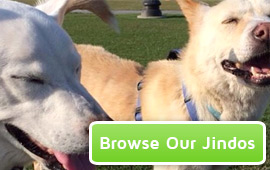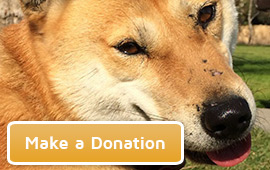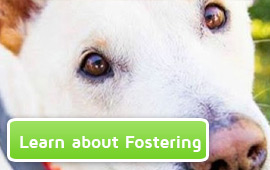The fearful dog
(From The Dumb Friends League)
Dogs may display a variety of behaviors when they are afraid. A frightened dog may try to escape, may show appeasement behaviors (avoidance of eye contact, fearful urinating, rolling over to expose his belly), or he may freeze and remain immobile. Some dogs will bark and/or growl at the object that is causing their fear. In extreme cases of fearfulness a dog may be destructive (out of general anxiety or in an attempt to escape), or he may lose control of his bladder or bowels and, therefore, house soil. A fearful dog will display certain body postures, including lowering his head, flattening his ears back against his head, and tucking his tail between his legs. He may also pant, salivate, tremble and/or pace.
Causes of Fearful Behavior
Determining why your dog is fearful is not always essential to treating the fearful behavior, although the reason for his fear will dictate the relative success of the treatment. A dog that is genetically predisposed to general fearfulness, or a dog that was improperly socialized during a critical stage in the development, will probably not respond as well to treatment as a dog that has developed a specific fear in response to a specific experience. It is essential, however, to first rule out any medical causes for your dog’s fearful behavior. Your first step should be to take your dog to your veterinarian for a thorough medical evaluation.
What You Can Do
Most fears will not go away by themselves, and if left untreated, may get worse. Some fear, when treated, will decrease in intensity or frequency but may not disappear entirely. Once medical reasons have been ruled out, the first step in dealing with your dog’s fearful behavior is to identify what triggers his fear. If he is afraid of startling noises see our handout: “Helping Your Dog Overcome the Fear of Thunder and Other Startling Noises”. If he is afraid of being left alone, see our handout: “Separation Anxiety”. Most fears can be treated using clicker training, desensitization, and counter-conditioning techniques (see our handout “Dog Clicker Training”).
Clicker Training
- □ Condition the clicker, by clicking and giving your dog a treat. Repeat 10 to 12 times.
- □ Once your dog is conditioned to the clicker, shape a new behavior, like spin or shake starting at a safe distance from the fear stimuli and then gradually decrease the distance to the stimuli. To shape a behavior you want to click and treat for any small approximations of the finished behavior. For instance, if you are shaping spin, then you would click and treat for any head movement in one direction, building up to your dog looking over his shoulder in that same direction, and then finally taking steps until he spins completely around.
Desensitization
- □ Begin by exposing your dog to a very low level or small amount of whatever it is that is causing his fear. For example, if he is afraid of bicycles, start with a bicycle placed at a distance of 100 feet from your dog.
- □ As long as your dog remains relaxed gradually move the bicycle closer to him. If at any point he becomes anxious, move the bicycle further away and proceed at a slower pace.
- □ When your dog can remain relaxed in the presence of a stationary bicycle, move the bicycle 100 feet away again and have someone slowly ride it around. Gradually increase the proximity of the slowly moving bicycle. Repeat this procedure as many times as necessary, increasing the speed of the moving bicycle.
- □ This process may take several days, weeks, or even months. You must proceed at a slow enough pace that your dog never becomes fearful during the desensitization process. Additionally, whatever causes the dog’s fearful reaction must be limited or (preferably) completely removed from his environment during times that you are not working on treatment.
Counter Conditioning
Counter conditioning works best when used along with desensitization. This involves teaching the dog a new reaction to the fear stimulus.
- □ Using the desensitization technique example described previously, when your dog is first exposed to the bicycle, give him praise. By pairing positive things with the bicycle, your dog will began to make good associations and overtime learn that whenever the bicycle appears, good things happen!
- □ Do not use punishment, collar corrections, or scolding. The point of counter conditioning is for him to always associate pleasant things with the thing that frightens him.
Realistic Expectations
Some of the things that frighten dogs can be difficult to reproduce and/or control. For example, if your dog is afraid of thunderstorms, he may be responding to other things that occur during the storm, such as smells, barometric pressure changes, and/or changes in the light. During the desensitization process it is impossible for you to reproduce all of these factors. If your dog is afraid of men, you may work at desensitizing him, but if an adult man lives in your household and your dog is constantly exposed to him, this can disrupt the gradual process of desensitization.
When to Get Help
Because desensitization and counter conditioning can be difficult to do, and because behavior problems may increase if these techniques are done incorrectly, you may want to get professional, in-home help from an animal behavior specialist (see our handout: “When the Behavior Helpline Can’t Help”). It is important to keep in mind that a fearful dog that feels trapped or is pushed too far may become aggressive. Some dogs will respond aggressively to whatever it is that frightens them (see our handout: “Understanding Aggression in Dogs”). If your dog displays any aggressive behavior, such as growling, snarling, snapping, or baring his teeth, stop all behavior modification procedures and seek professional help from an animal behavior specialist as soon as possible.
Consult With Your Veterinarian
Medication may be available that can help your dog feel less anxious for short time periods. Your veterinarian is the only person who is licensed and qualified to prescribe medication for your dog. Do not attempt to give your dog any over-the-counter or prescription medication without consulting with your veterinarian. Animals do not respond to drugs the same way people do, and a medication that may be safe for humans could be fatal to your dog. Drug therapy alone will not reduce fears and phobias permanently. In extreme cases, behavior modification and medication used together may be the best approach.
New Products
There are products being marketed by reputable companies to help with anxiety and stress relief in dogs. Please note that none of these is an automatic cure for fear/anxiety, but should be used in conjunction with behavior modification techniques. Please see our handout “Stress Relief for Your Pet” for more information.
What Not To Do
- □ Do not punish your dog for being afraid. Punishment will only make him more fearful. That includes punishment after the fact for destruction or house soiling caused by anxiety or fear. Animals do not understand punishment after the fact, even if it is only seconds later. This kind of destruction or house soiling is the result of panic not misbehavior.
- □ Do not try to force your dog to experience the object or situation that is causing him to be afraid. For example, if he is afraid of bicycles and you force him to stand in place while bicycles whiz by, he will probably become more fearful, rather than less fearful of bicycles.
©2014 Dumb Friends League



